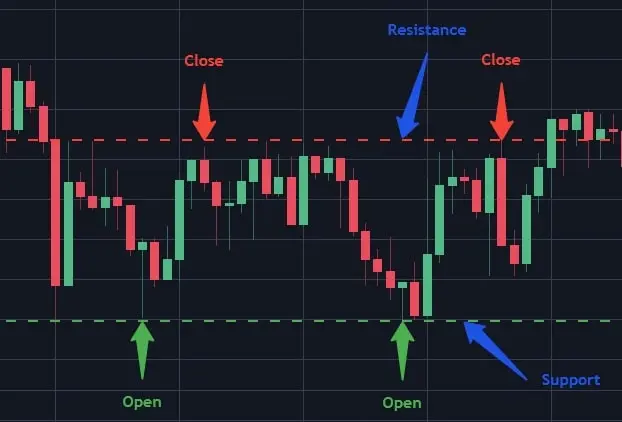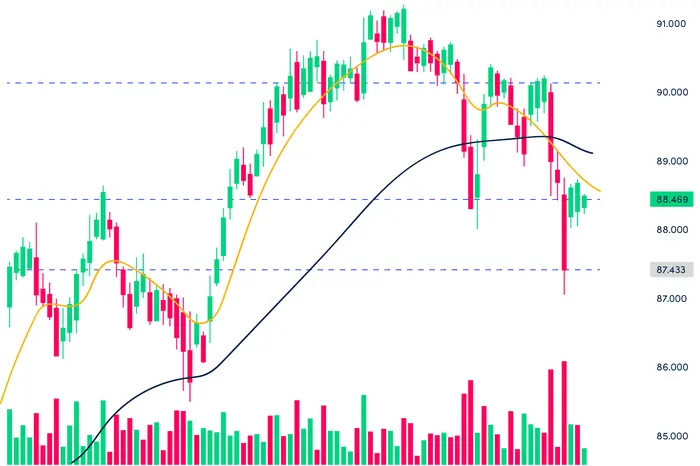Making money in crypto doesn’t always mean taking big risks. Smart traders use a strategy called options arbitrage to profit from price differences between exchanges.
This method works by spotting when the same cryptocurrency option trades at different prices on different platforms.
You can earn profits by buying crypto options at lower prices on one exchange and selling them at higher prices on another. This type of trading takes advantage of market inefficiencies and pricing mistakes that happen naturally in the crypto world.
A key benefit of options arbitrage is that it can work in any market condition.
Unlike regular crypto trading where you need prices to go up or down, arbitrage opportunities exist when markets are stable, rising, or falling.
You just need to find the right price gaps between exchanges and act quickly to capture the difference.
Understanding Crypto Options
Crypto options give you specific rights to buy or sell cryptocurrencies at set prices within certain time periods. These financial tools help manage risk and create opportunities for profit through strategic trading.
Defining Crypto Options
A crypto option is a contract that lets you buy or sell a cryptocurrency at a preset price before a specific date.
The preset price is called the strike price, and the end date is the expiration date.
You’ll pay a fee called a premium to get these rights. The premium protects you from price drops while letting you benefit from price increases.
Two key terms to know:
- Call options: Right to buy crypto at the strike price
- Put options: Right to sell crypto at the strike price
Types of Crypto Options
American-style options let you exercise the contract any time before expiration. European-style options only allow exercise on the expiration date.
Common crypto option varieties:
- Cash-settled options
- Physically-delivered options
- Vanilla options
- Exotic options
Most crypto exchanges offer vanilla call and put options. These basic types work well for new traders.
Options Pricing Fundamentals
The price of crypto options depends on several factors:
- Current crypto price
- Time until expiration
- Market volatility
- Strike price
- Interest rates
Key pricing components:
- Intrinsic value: Difference between market price and strike price
- Time value: Extra premium based on remaining time
Higher volatility makes options more expensive. Longer expiration times also increase prices.
Trading platforms use complex formulas like the Black-Scholes model to calculate fair option prices.
Arbitrage Basics
Making money from price differences requires quick actions and careful attention to market conditions. Trading the same asset at different prices lets you lock in profits with minimal risk.
What is Arbitrage?
Arbitrage means buying and selling the same asset simultaneously in different markets to profit from price differences. You can make money when markets value the same thing differently.
Your profit comes from the gap between the buying price in one market and the selling price in another. The key is to act fast before other traders spot the opportunity and close the price gap.
Successful arbitrage needs three things: access to multiple markets, enough money to trade, and speed to execute before prices change.
Arbitrage in Traditional Markets
Stock traders use arbitrage between exchanges like NYSE and NASDAQ. They spot tiny price differences that last for seconds or minutes.
Currency traders practice arbitrage in the forex market by exchanging different currencies across global markets. They might buy euros in London and sell them in Tokyo.
Stock index arbitrage involves trading index futures against the actual stocks in the index. When prices don’t match perfectly, traders can profit from the difference.
Arbitrage Opportunities in Crypto Markets
Crypto prices often vary significantly between different exchanges. You might find Bitcoin selling for $50,000 on one exchange and $50,200 on another.
Price gaps appear more often in crypto because:
- Markets operate 24/7
- Exchanges work independently
- Trading volumes differ
- Some exchanges have limited liquidity
You can find arbitrage chances in:
- Spot vs. futures prices
- Different trading pairs (BTC/USD vs. BTC/EUR)
- Options premiums across exchanges
Identifying Mispricing in Crypto Options
Crypto options markets often create price differences between exchanges and implied volatility levels. These gaps present chances to make profits through strategic trading.
Volatility and Mispricing
Implied volatility reveals what the market thinks about future price movements. When implied volatility differs between exchanges for the same option, it signals potential mispricing.
You can spot these differences by comparing options with similar strike prices and expiration dates across platforms like Deribit and Delta Exchange. Key metrics to watch:
- Implied volatility skew
- Historical vs implied volatility spread
- Term structure variations
Tools like Python-based volatility surface analysis help track these patterns automatically. Look for options where implied volatility seems too high or low compared to similar contracts.
Liquidity and Market Inefficiencies
Market depth affects how easily you can execute arbitrage trades. Lower liquidity often creates bigger price gaps between exchanges.
Common inefficiencies to watch for:
- Wide bid-ask spreads
- Order book imbalances
- Delayed price updates between venues
Trading volume patterns can signal which options might be mispriced. Peak trading hours typically show smaller spreads, while off-hours may reveal larger gaps.
Check the open interest levels before trading. Low open interest might mean harder exits from positions despite attractive price differences.
Strategies for Options Arbitrage

Options arbitrage in crypto markets involves taking advantage of price differences between related options contracts to generate consistent profits with minimal risk.
Spread Arbitrage
Spread arbitrage focuses on exploiting price differences between similar options on different exchanges. You can buy options at lower prices on one exchange while selling them at higher prices on another.
To execute this strategy, monitor options prices across major crypto exchanges like Deribit and Delta. Look for options with identical strike prices and expiration dates that show price discrepancies.
Calculate transaction fees and withdrawal costs before placing trades. These costs can eat into potential profits.
Use automated trading tools to spot opportunities quickly. Markets move fast, and price differences often disappear within seconds.
Box Arbitrage
Box arbitrage combines four different options positions to create a risk-free profit opportunity. You simultaneously trade calls and puts at two different strike prices.
The strategy involves:
- Buying a call at strike price A
- Selling a call at strike price B
- Buying a put at strike price B
- Selling a put at strike price A
This creates a “box” that locks in a guaranteed profit when the prices are misaligned. The profit equals the difference between what you pay and the spread between strike prices.
Calendar Spread Arbitrage
Calendar spread arbitrage profits from price differences between options with different expiration dates but the same strike price.
You can buy longer-dated options while selling shorter-dated ones when their prices don’t align with theoretical values. This strategy takes advantage of time decay differences.
Watch for changes in implied volatility, as this affects option pricing across different expiration dates. Higher volatility typically increases the value of longer-dated options more than shorter ones.
Keep position sizes small to manage risk. Market conditions can change rapidly in crypto markets.
Risk Management

Managing risk is essential when trading crypto options arbitrage. Proper risk controls and portfolio diversification help protect your capital while maximizing potential returns.
Assessing Risk-Reward Ratios
You need to calculate the potential profit against possible losses before entering any arbitrage trade. Set strict profit targets and stop-loss levels for each position.
Use a risk-reward ratio of at least 1:3, meaning your potential profit should be three times greater than your maximum allowed loss.
Track price volatility and liquidity across different exchanges. Low liquidity can make it difficult to execute trades quickly, increasing your exposure to price changes.
Monitor transaction fees and slippage costs. These can eat into your profits and must be factored into your risk calculations.
Diversification Strategies
Split your trading capital across multiple arbitrage opportunities rather than concentrating on a single trade.
Trade different cryptocurrency pairs to reduce your exposure to any single asset’s price movements.
Consider using multiple exchanges to avoid platform-specific risks. Keep no more than 20% of your total trading capital on any single exchange.
Create a balanced portfolio by mixing various arbitrage strategies:
- Exchange arbitrage
- Futures vs spot arbitrage
- Options vs underlying asset arbitrage
Set position size limits for each trade. A good rule is risking no more than 2% of your total trading capital per position.
Technical Analysis for Arbitrage

Technical analysis helps you spot price differences and trading opportunities across crypto exchanges using data-driven tools and patterns.
Chart Patterns and Indicators
Price charts reveal key arbitrage opportunities through common patterns. Divergence indicators compare price movements between exchanges to find mismatches.
Moving averages help identify price trends and potential arbitrage entry points. The Relative Strength Index (RSI) shows when assets are overbought or oversold on different platforms.
Bollinger Bands measure price volatility and highlight when rates deviate too far from normal ranges – a key signal for arbitrage trades.
Pay attention to trading volume indicators. High volume suggests better liquidity for executing arbitrage trades quickly.
Algorithmic Trading Tools
Trading bots automate the arbitrage process by constantly scanning exchanges for price gaps. These tools can execute trades in milliseconds when opportunities appear.
Popular arbitrage bot features:
- Real-time price monitoring across exchanges
- Automated order execution
- Risk management controls
- Performance tracking
Many platforms offer pre-built arbitrage algorithms you can customize. Start with basic bots while learning, then advance to more complex strategies.
Consider using APIs to build custom trading tools. This gives you more control over your arbitrage strategy and execution speed.
Fundamental Analysis in Arbitrage
Tracking market data helps identify profitable arbitrage opportunities in the crypto options markets. Fundamental analysis looks at key economic factors and market sentiment that create price differences between exchanges.
Market Sentiment and News
You need to monitor social media, news sites, and crypto influencers to gauge market sentiment. Major announcements about regulations, hacks, or adoption can create temporary price gaps between exchanges.
Watch Reddit communities and Twitter hashtags to spot emerging narratives that might affect prices. Set up news alerts for your target cryptocurrencies.
Key sentiment indicators to track:
- Social media mentions and sentiment
- Google search trends
- Trading volume changes
- Media coverage tone
Economic Indicators
Macro factors create arbitrage opportunities when markets react differently to economic news. Pay attention to inflation data, interest rates, and regulatory developments.
Track correlations between crypto and traditional markets. Bitcoin often moves with tech stocks while stablecoins react to USD strength.
Important indicators:
- Interest rate decisions
- Inflation reports
- GDP growth numbers
- Regulatory announcements
Review economic calendars daily to prepare for market-moving events. Focus on data from major economies like the US, EU, and China.
Regulatory Considerations
Legal Framework for Crypto Trading
Crypto arbitrage trading is legal in most countries, but you must follow specific regulations.
Your trades need to comply with anti-money laundering (AML) and know-your-customer (KYC) requirements.
Tax authorities classify crypto arbitrage profits as capital gains in many jurisdictions.
You’ll need to maintain detailed records of all transactions for tax reporting.
Key compliance requirements:
- Trading activity documentation
- Transaction history records
- Proof of wallet ownership
- Income reporting forms
Cross-Jurisdictional Challenges
Different countries have varying rules about crypto trading and tax treatment.
Some nations restrict certain types of crypto transactions or exchanges.
You must verify the legality of arbitrage trading in each jurisdiction where you operate.
This includes both your home country and the locations of the exchanges you use.
Important considerations:
- Exchange licensing requirements
- Regional trading restrictions
- International tax obligations
- Currency conversion rules
Working with a qualified tax professional can help ensure proper compliance across multiple jurisdictions.
Executing Crypto Options Arbitrage
Trading crypto options arbitrage requires careful platform selection and precise order timing to capture profits from price differences.
Success depends on quick execution and having accounts ready on multiple exchanges.
Choosing a Trading Platform
Deribit and Delta are two major exchanges that offer crypto options trading with good liquidity.
You need verified accounts on at least 2-3 exchanges to spot and execute arbitrage opportunities.
Make sure your chosen platforms have:
- Low trading fees
- Fast order execution
- Reliable API access
- Deep order books
- Quick withdrawals
The platforms must support the specific crypto options products you plan to trade.
Check the available strike prices, expiration dates, and contract sizes.
Order Execution Tactics
Speed is critical when executing arbitrage trades.
Set up automated trading tools to scan for price differences and place orders quickly.
Key tactics for successful execution:
- Place both legs of the trade nearly simultaneously
- Use limit orders to get better fill prices
- Keep funds split between exchanges
- Monitor spreads continuously
- Start with small test trades
Have backup trading strategies ready if market conditions change suddenly.
Focus on liquid options with tight bid-ask spreads to minimize execution risks.
Watch transaction costs carefully – fees can quickly eat into arbitrage profits.
Consider using maker orders when possible to reduce costs.
Performance Analysis
Accurate performance tracking and strategy refinement are essential elements of successful crypto options arbitrage trading.
Regular analysis helps identify winning approaches and areas needing adjustment.
Measuring Profitability
Track your profit and loss (P&L) daily using a structured spreadsheet or trading journal.
Record each trade’s entry price, exit price, fees, and holding period.
Calculate key metrics to evaluate strategy effectiveness:
- Return on Investment (ROI): (Net Profit / Initial Investment) x 100
- Sharpe Ratio: Measure risk-adjusted returns
- Win Rate: Percentage of profitable trades
- Average Trade Duration: Time between entry and exit
Compare performance across different exchanges and trading pairs. This helps identify which markets offer the best arbitrage opportunities.
Monitoring and Adjusting Strategies
Set up automated alerts for price discrepancies above your minimum threshold. This ensures you catch profitable opportunities quickly.
Review these key factors weekly:
- Price spread patterns
- Trading volume changes
- Fee structures
- Market liquidity levels
Make data-driven adjustments to your strategy based on market conditions.
If certain pairs consistently underperform, consider removing them from your trading rotation.
Test strategy modifications with small position sizes before scaling up.
This reduces risk while validating changes to your approach.
Frequently Asked Questions
Traders need clear answers about the practical aspects of cryptocurrency options arbitrage to execute profitable trades and manage potential risks effectively.
What strategies are commonly used for cryptocurrency options arbitrage?
You can use delta-neutral strategies to profit from price differences between options contracts. This involves buying underpriced options while selling overpriced ones.
Cross-exchange arbitrage lets you take advantage of different option prices across multiple trading platforms simultaneously.
Time decay arbitrage focuses on profiting from the varying speeds at which similar options lose value on different exchanges.
What are the risks associated with arbitrage trading in the crypto market?
Execution risk can cause trades to fail if prices change before your orders are filled. This happens often in fast-moving crypto markets.
High trading fees and withdrawal limits may eat into your profits or prevent you from moving funds quickly between exchanges.
Smart contract vulnerabilities and exchange hacks pose security risks to your trading capital.
How do market inefficiencies enable profit through crypto arbitrage?
Price gaps appear when different exchanges have varying levels of liquidity and trading volume. These gaps create opportunities for profit.
Some exchanges update their prices more slowly than others, leading to temporary mismatches you can exploit.
Market maker incentives and rebate programs can create artificial price differences between platforms.
Are there specific tools or software recommended for identifying crypto arbitrage opportunities?
Trading bots with API connections to multiple exchanges help spot price differences in real-time.
Data aggregators like CoinGecko and CryptoWatch display price feeds from various exchanges on one screen.
Custom spreadsheet templates can help track potential arbitrage opportunities and calculate expected profits.
How does volatility in the cryptocurrency market affect options arbitrage strategies?
High volatility creates larger price discrepancies between exchanges, potentially increasing profit opportunities.
Rapid price swings make it harder to execute trades quickly enough to capture profits.
Volatility affects options premiums differently across exchanges, creating more chances for arbitrage.
What are the legal and regulatory considerations for engaging in crypto options arbitrage?
You must verify that your chosen exchanges comply with local trading regulations and reporting requirements.
Tax obligations vary by country, and you need to keep detailed records of all arbitrage trades.
Some jurisdictions restrict certain types of derivatives trading or require special licenses for options trading.
